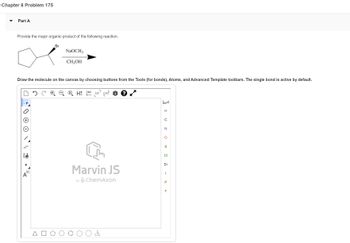
Chemistry
10th Edition
ISBN: 9781305957404
Author: Steven S. Zumdahl, Susan A. Zumdahl, Donald J. DeCoste
Publisher: Cengage Learning
expand_more
expand_more
format_list_bulleted
Concept explainers
Question

Transcribed Image Text:## Chapter 8 Problem 175
### Part A
**Objective:** Provide the major organic product of the following reaction.
**Reaction Details:**
A cyclopentyl bromide is reacted with sodium methoxide (NaOCH₃) in methanol (CH₃OH).
**Instructions:**
Draw the molecule on the canvas by choosing buttons from the Tools (for bonds), Atoms, and Advanced Template toolbars. The single bond is active by default.
---
### Diagram Tools:
- **Toolbar Options:**
- **Undo/Redo:** For correcting mistakes.
- **Bond Tools:** To add single, double, or triple bonds.
- **Atom Tools:** To add different elements (C, H, O, N, etc.).
- **Template Library:** For quickly adding complex structures.
- **Elements Available:**
- H (Hydrogen), C (Carbon), N (Nitrogen), O (Oxygen), S (Sulfur), Cl (Chlorine), Br (Bromine), I (Iodine), P (Phosphorus), F (Fluorine).
**Canvas Details:**
- A workspace labeled "Marvin JS" by ChemAxon is provided for creating chemical structures.
Explore each tool to efficiently draw and predict the product of the given reaction.
Expert Solution
This question has been solved!
Explore an expertly crafted, step-by-step solution for a thorough understanding of key concepts.
This is a popular solution
Trending nowThis is a popular solution!
Step by stepSolved in 2 steps with 1 images

Knowledge Booster
Learn more about
Need a deep-dive on the concept behind this application? Look no further. Learn more about this topic, chemistry and related others by exploring similar questions and additional content below.Similar questions
- Chemistry 1) Using the (E)-(Z) designation [and in parts (e) and (f) the (R)-(S) designation as well] give IUPAC names for each of the following: (b) (c) HC (d) (e) ہو 3 CH, CH, Họ H H CH₂arrow_forwardDraw the structure of the major organic product(s) of the reaction.arrow_forwardo-Chem help! Question belarrow_forward
- 4:54 ♥ Name: I. H₂C HC GC1-WS2-OrgChem_-188186675 Activity 2.2 Worksheet on Organic Chemistry Grade, Strand, & Section: Date: Complete the Table. Complete the table below. Each row is worth 5 points. Given Compound 2,3-dimethylpentane 4,4-dimethylpentyne CH₁₂ CH₂ H₁C H₂C CH₂ 3-ethyl-1-hexene 1,4-cyclohexdiene NH₂ CH CH2 Classification of Compound via Name/Structure of Compound Number of Bonds (Saturated/ Unsaturated) C-C Bonding (Aliphatic/ Cyclic) II. Identification. Encircle and name the functional group in each structure. 2 points will be allotted for each number. CH3 CH HC CH HC Н2 H3C Н2 si e H3C SH H3C 5. `NH₂ OH H₂C 3. 72 Score: /50 Type of Hydrocarbon (Alkane, Alkene, Alkyne, Aromatic) CH3 Edit Print Upload to Cloud Share Morearrow_forwardQuestion 15arrow_forward5arrow_forward
- 2arrow_forwarddetermine the limiting reagent,theoretical yeild, and precent yeild for the synthesis of 2-Methyl-4-heptanone : mass of 2-methyl-4-heptanol: 1.0 g. mass 2-Methyl-4-heptanone : 0.77garrow_forwardBr + NaSH H F CH3 Draw the molecule on the canvas by choosing buttons from the Tools (for bonds and charges), Atoms, and Templates toolbars. Show the appropriate stereochemistry by choosing the dashed or wedged buttons and then clicking a bond on the canvas.arrow_forward
- Chemistry: 1) SAM reacts with nucleophiles in an SN2-like reaction in our body for a variety of important biosynthetic reactions. Below on the molecule of SAM, please circle and label which part of the molecule would act as the electrophile, and which part of the molecule is the leaving group. (5 pts) HO NH2 NH2 N N CH 3 N Z -S: + 'OH OH S-Adenosyl methioninearrow_forwardPredict the major product formed when the compounds shown below react with each other under the influence of heat. Interactive 3D display mode H₂C Ph CI CH2 H₂C Draw the molecule on the canvas by choosing buttons from the Tools (for bonds), Atoms, andarrow_forward
arrow_back_ios
arrow_forward_ios
Recommended textbooks for you
 ChemistryChemistryISBN:9781305957404Author:Steven S. Zumdahl, Susan A. Zumdahl, Donald J. DeCostePublisher:Cengage Learning
ChemistryChemistryISBN:9781305957404Author:Steven S. Zumdahl, Susan A. Zumdahl, Donald J. DeCostePublisher:Cengage Learning ChemistryChemistryISBN:9781259911156Author:Raymond Chang Dr., Jason Overby ProfessorPublisher:McGraw-Hill Education
ChemistryChemistryISBN:9781259911156Author:Raymond Chang Dr., Jason Overby ProfessorPublisher:McGraw-Hill Education Principles of Instrumental AnalysisChemistryISBN:9781305577213Author:Douglas A. Skoog, F. James Holler, Stanley R. CrouchPublisher:Cengage Learning
Principles of Instrumental AnalysisChemistryISBN:9781305577213Author:Douglas A. Skoog, F. James Holler, Stanley R. CrouchPublisher:Cengage Learning Organic ChemistryChemistryISBN:9780078021558Author:Janice Gorzynski Smith Dr.Publisher:McGraw-Hill Education
Organic ChemistryChemistryISBN:9780078021558Author:Janice Gorzynski Smith Dr.Publisher:McGraw-Hill Education Chemistry: Principles and ReactionsChemistryISBN:9781305079373Author:William L. Masterton, Cecile N. HurleyPublisher:Cengage Learning
Chemistry: Principles and ReactionsChemistryISBN:9781305079373Author:William L. Masterton, Cecile N. HurleyPublisher:Cengage Learning Elementary Principles of Chemical Processes, Bind...ChemistryISBN:9781118431221Author:Richard M. Felder, Ronald W. Rousseau, Lisa G. BullardPublisher:WILEY
Elementary Principles of Chemical Processes, Bind...ChemistryISBN:9781118431221Author:Richard M. Felder, Ronald W. Rousseau, Lisa G. BullardPublisher:WILEY

Chemistry
Chemistry
ISBN:9781305957404
Author:Steven S. Zumdahl, Susan A. Zumdahl, Donald J. DeCoste
Publisher:Cengage Learning

Chemistry
Chemistry
ISBN:9781259911156
Author:Raymond Chang Dr., Jason Overby Professor
Publisher:McGraw-Hill Education

Principles of Instrumental Analysis
Chemistry
ISBN:9781305577213
Author:Douglas A. Skoog, F. James Holler, Stanley R. Crouch
Publisher:Cengage Learning

Organic Chemistry
Chemistry
ISBN:9780078021558
Author:Janice Gorzynski Smith Dr.
Publisher:McGraw-Hill Education

Chemistry: Principles and Reactions
Chemistry
ISBN:9781305079373
Author:William L. Masterton, Cecile N. Hurley
Publisher:Cengage Learning

Elementary Principles of Chemical Processes, Bind...
Chemistry
ISBN:9781118431221
Author:Richard M. Felder, Ronald W. Rousseau, Lisa G. Bullard
Publisher:WILEY